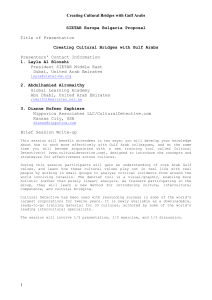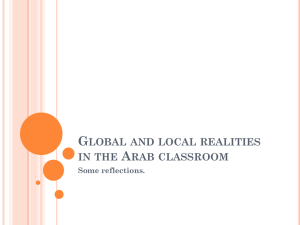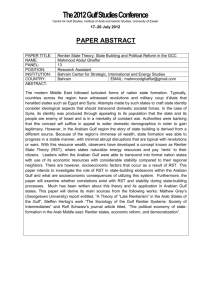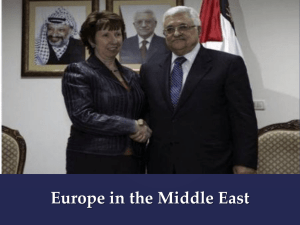Ethnocracy in the Arab Gulf States*: Preliminary Analysis of Recent
advertisement
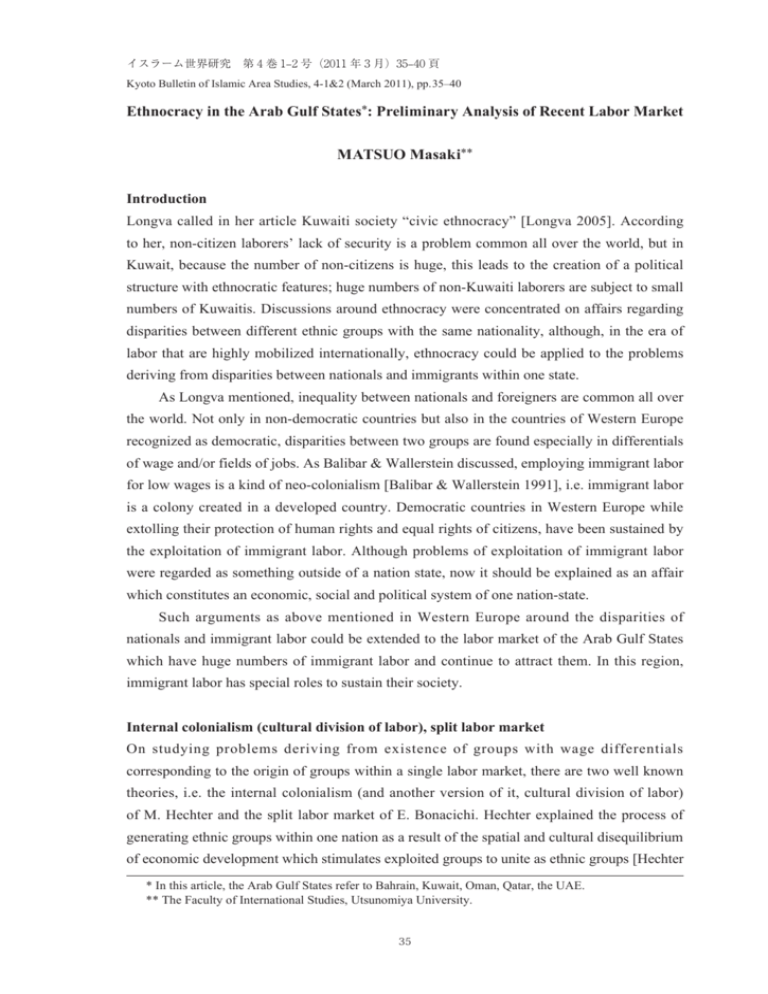
イスラーム世界研究 第 4 巻 1–2 号(2011 年 3 月)35–40 頁 Ethnocracy in the Arab Gulf States Kyoto Bulletin of Islamic Area Studies, 4-1&2 (March 2011), pp. 35–40 Ethnocracy in the Arab Gulf States*: Preliminary Analysis of Recent Labor Market MATSUO Masaki** Introduction Longva called in her article Kuwaiti society “civic ethnocracy” [Longva 2005]. According to her, non-citizen laborers’ lack of security is a problem common all over the world, but in Kuwait, because the number of non-citizens is huge, this leads to the creation of a political structure with ethnocratic features; huge numbers of non-Kuwaiti laborers are subject to small numbers of Kuwaitis. Discussions around ethnocracy were concentrated on affairs regarding disparities between different ethnic groups with the same nationality, although, in the era of labor that are highly mobilized internationally, ethnocracy could be applied to the problems deriving from disparities between nationals and immigrants within one state. As Longva mentioned, inequality between nationals and foreigners are common all over the world. Not only in non-democratic countries but also in the countries of Western Europe recognized as democratic, disparities between two groups are found especially in differentials of wage and/or fields of jobs. As Balibar & Wallerstein discussed, employing immigrant labor for low wages is a kind of neo-colonialism [Balibar & Wallerstein 1991], i.e. immigrant labor is a colony created in a developed country. Democratic countries in Western Europe while extolling their protection of human rights and equal rights of citizens, have been sustained by the exploitation of immigrant labor. Although problems of exploitation of immigrant labor were regarded as something outside of a nation state, now it should be explained as an affair which constitutes an economic, social and political system of one nation-state. Such arguments as above mentioned in Western Europe around the disparities of nationals and immigrant labor could be extended to the labor market of the Arab Gulf States which have huge numbers of immigrant labor and continue to attract them. In this region, immigrant labor has special roles to sustain their society. Internal colonialism (cultural division of labor), split labor market On studying problems deriving from existence of groups with wage differentials corresponding to the origin of groups within a single labor market, there are two well known theories, i.e. the internal colonialism (and another version of it, cultural division of labor) of M. Hechter and the split labor market of E. Bonacichi. Hechter explained the process of generating ethnic groups within one nation as a result of the spatial and cultural disequilibrium of economic development which stimulates exploited groups to unite as ethnic groups [Hechter * In this article, the Arab Gulf States refer to Bahrain, Kuwait, Oman, Qatar, the UAE. ** The Faculty of International Studies, Utsunomiya University. 35 Kyoto Bulletin of Islamic Area Studies 4-1&2 (March 2011) 1975; 1978]. And Bonacichi explained the emergence of ethnic antagonism as resulting from wage differentials between ethnic groups; immigrant labor bear low wages (because it is high comparing to countries of their origins and they don’t want to reside in host countries for long), then employers tend to promote hiring them and main national labor want to prevent it; as a result, conflicts emerge between these three groups which lead to ethnic problems [Bonacichi 1972; 1975; 1976]. Both theories have a common feature regarding the generation of ethnic groups as not emotional or absurd, but rational. Also, we can find points of difference between the two. The most important of them here is the status of groups earning lower wages. While Hechter discussed differentials between developed and underdeveloped groups within one nation, Bonacichi dealt with groups of laborers classifiable into national and immigrant/imported labor. According to Hechter, labor with lower wages on the Celtic fringes could be categorized into certain ethnic group such as Celts, and also into British nationals at the same time (that’s why this could be problematized as an “internal” colony). Bonacichi, on the other hand, premised that wage differentials derive from immigrants’ motives that are very different from national labor, i.e. motives of temporary labor; not only can they bear undesirable work but they also have little reason to join unions to engage in lengthy conflict to get higher wages because they are temporary labor. This difference between Hechter and Bonacichi, problems of labor of the same nationality, and problems of nationals and imported groups, would prevent us from easily applying these two theories at one time. Internal colonialism is a matter of inequality within one nation and this implies that this should be solved to create equality. Conflict between national labor and imported labor should also be solved, but centrally so as not to create equality between nationals and imported labor but to limit the use of imported labor, or, to keep the split labor market to protect national labor. This difference is similar to the difference between the discussion of ethnocracy and immigrant labor in the introduction. And, as we confirmed in the introduction that ethnocracy as a frame of study could be applied to the study of exploiting immigrant labor, both internal colonialism and the split labor market theory could be applied to the study of the labor market of the Arab Gulf States. Labor market in the Arab Gulf States According to the split labor market theory, some processes appear after the import of labor: ● nationals are challenged by imported labor because the latter have more wage competitiveness than the former and conflict emerges between nationals (especially with low wages) and imported labor; 36 Ethnocracy in the Arab Gulf States ● nationals with low wages stand against imported labor demanding that the government limits them in number or their fields of employment; ● if national labor with low wages have more influence than employers who want to use imported labor, a limitation act will be approved, and if not, national labor will lose and the conflict will continue; ● if nationals and imported labor should make a joint front to demand a raise in wages, employers can import another labor from abroad and use them as strike breakers. In the Arab Gulf States at present there is no such action by nationals as listed above. Why don’t nationals protest against employers or the government? To solve this question, we have to explore the labor markets in the Arab Gulf States. At first, we have to pay attention to the drive of the economy in the Arab Gulf States, oil. The economic prosperity of the Arab Gulf States attracts huge numbers of labor from abroad and this prosperity stands on oil exportation. Although, even before oil, there were immigrant labor in the Arab Gulf States, their number was small. After oil exportation started around the 1940’s to 50’s an economic boom came and these states suffered from a shortage of labor. Then, importation of labor inevitably started. During the first few decades, a split labor market favorable to nationals did not exist. Although the rulers of the Arab Gulf States were eager to promote international oil companies to hire their subjects, many labor were imported from abroad because there were few skilled or educated national labor in these countries [Seccombe & Lawless 1986]. According to Louër, who studied labor immigration in Bahrain, “Most of the Bahrainis worked on a daily non-contract basis” during 1930’s to 1960’s, and this “led to the creation of a trade union, the Bahrain Labor Federation (October 1955) with 6000 members, and to the drafting of labor legislation subsequently submitted to the rulers” [Louër 2008: 35]. This incident clearly suggests that Bonacichi’s discussion could be well applied to the Arab Gulf States, at least at the first stage of oil economy. But, in the following decades, they continued to import labor from abroad, until now. Why were labor movements calmed down without governments’ altering the labor-import policy? And why is there no labor action from nationals protesting against this policy? Table 1 shows the answer to these questions. In Kuwait, the number of employed Kuwaitis has grown from 23,924 in 1966 to 206,960 in 2005 and “expatriates” also grew from 54,960 in 1966 to 1,402,154. In 1966, 58% of total Kuwaiti labor were working in the public sector, and in 2005 it jumped to 81.6%. During same period, the percentage of “expatriates” working in the public sector decreased from 25.5% to 4.1%. This statistical analysis clearly indicates that most Kuwaiti labor newly entered into the labor market after finishing required education were absorbed into the public sector, while “expatriates” were placed in the private 37 Kyoto Bulletin of Islamic Area Studies 4-1&2 (March 2011) sector. As Kapizsewski explained, in the Arab Gulf States, national labor working in the public sector enjoy high wages compared to the private sector, and are provided with pensions and prestige as if they are “labor aristocracy” [Kapizsewski 2001: 17]. Table 1: Labor market of Kuwait (from 1966 to 2005, Kuwaitis, Expatriates, Public sector) 1966 1975 1985 1995 2005 Total number of employed Kuwaitis 23,924 91,844 95,812 142,204 206,960 Total number of employed expatriates 54,960 211,444 566,240 603,497 1,402,154 Kuwaitis 14,290 43,340 53,283 134,196 168,974 Public sector Expatriates 14,051 51,290 82,770 90,481 57,537 Ratio of Kuwaitis in public sector 58.0 47.1 55.6 94.3 81.6 Ratio of expatriates in public sector 25.5 24.2 14.6 14.9 4.1 Source: Ministry of Planning (Kuwait), 1996, 2008. As long as a government can supply national labor with well paid jobs, and the speed of economic growth of the state can exceed (or at least keep up with) the growth of the national labor force, conflict between nationals and immigrants in a labor market may not occur. In the Arab Gulf States the Profit from oil export enables this. The expansion of the public sector absorbs national labor and increases their disposable income which they invest into the private sector, in which “expatriates” are hired for low wages. Although during the first few decades of the oil economy, national labor received less pay than skilled immigrant labor and this led to labor movements, an upper shift of most of national labor emerged as a result of allocating the profit of oil exports through jobs in the public sector and this led to the cessation of labor movements. Nationals occupying small portion of total number of residents enjoy life in a welfare state and immigrant labor constituting huge part of residents in number (from around 25% in Oman to 80% in the UAE) serves nationals as low wage labor. It cannot be overstated that the private sector of the Arab Gulf States cannot function without immigrant labor, because the private sector comprises most of the activities which compose a society. Immigrant labor are just like a group living in an internal colony artificially created by oil profit; they are imported for national benefit as subjects to be exploited. Hechter referred to the probability of the transformation of the feeling of deprivedness of a group which is culturally distinctive and in a low position in the stratification system into an ethnic identity [Hechter 1978: 298–299], and this is the very central point of his “cultural division of labor” theory which explains the creation of ethnic groupings. But in the Arab Gulf States this explanation is made inversely. Feelings of the privilegedness of an indigenous group will be transformed into a national consciousness. This is what Longva called the “civic ethnocracy” of the Arab Gulf States which divides residents into ruling and ruled, rich and exploited, along with citizenship and making nationals think themselves empowered. 38 Ethnocracy in the Arab Gulf States Future of Ethnocracy in the Arab Gulf States Because of the huge oil and gas reserve and the small population of nationals, Kuwait, the UAE, and Qatar will keep their ethnocracy for some decades. Conversely, Bahrain and Oman have obstacles to continuing it, because their oil and gas reserve is limited and/or its population is relatively large. Regarding Bahrain, as Louër discussed, “(t)he current Bahraini labor market is very similar to the situations described by Edna Bonacich as a ‘split labor market’ ” [Louër 2008:44]. There is a tension between nationals and immigrant laborers. In Oman, though the young generation is waiting for jobs, the expansion of the public sector is coming to an end while dependence on immigrant laborers does not end [Wincker 2000]. Where will these symptoms for labor unrest lead these two countries? According to Bonacichi, there are some options; one is a conflict between national and immigrant labor, and/or between nationals and employers, and the other is the protest of nationals against their government’s policy on immigrant labor. In these cases, it is important who the employers are and where the protests lead. According to Looney, the low income group is constituted of rural Shia residents, while merchants and the Sunni ruling elites (i.e. ruling family and groups with close relations to it) are earning profit by using immigrant labor [Looney 1990: 171–2]. This implies that it is difficult for Bahrain to alter its labor importation policy because proponents of this policy are ruling elites who constitute of its government. So, when the advantages in the labor market disappear for some nationals, a low income group of nationals (i.e. rural Shia) will protest against government and employers of immigrant laborers (i.e. mostly urban Sunna), this protest leads to an anti-regime movement with an appearance of ethnic/religious conflict (i.e. Shia versus Sunna). As to Oman, different from Bahrain, its regime is not “dynastic monarchy” in which royal family rules as a group rather “monarchy” in which a ruler (Sultan Qabus) rules alone, no strong ruling elites appear and the coincidence of the rulings and proponents of the labor importation policy is not found. Also in Oman, the ethnic composition is more complex than Bahrain for there are some ethnic groups such as Zanzibari, Ibadhi, Sunni, Shia and Hindu. In Oman no conflict between ethnic groups and the ruling and the ruled have been reported since the launch of Qabus regime that has ruled until now, this is because the ethnic diversity of nationals prevents from emerging “cultural division of labor” as in Bahrain. So it could be forecast that the government of Oman can alter the labor importation policy slowly and the ethnocracy will dissolve relatively in peace. References Balibar, E. and Wallerstein, I. 1991. Race, Nation, Class: Ambiguous Identities. London: Verso. 39 Kyoto Bulletin of Islamic Area Studies 4-1&2 (March 2011) Bonacichi, E. 1972. “A Theory of Ethnic Antagonism: the Split Labor Market,” American Sociological Review 37 (October), pp. 547–559. ———. 1975. “Abolition, the Extension of Slavery, and the Position of Free Blacks: a Study of Split Labor Markets in the United States,” The American Journal of Sociology 81(3) (November), pp. 601–623. ———. 1976. “Advanced Capitalism and Black / White Race Relations in the United States: a Split Labor Market Interpretation,” American Sociological Review 41(1) (February), pp. 34–51. Hechter, M. 1975. Internal Colonialism: the Celtic Fringe in British National Development. Berkeley: University of California Press. ———. 1978. “Group Formation and the Cultural Division of Labor,” The American Journal of Sociology 84(2) (September), pp. 293–318. Kapiszewski, A. 2001. Nationals and Expatriates: Population and Labour Dilemmas of the Gulf Cooperation Council States. Reading: Garnet Publishing. Longva, A. N. 2005. “Neither Autocracy nor Democracy but Ethnocracy: Citizens, Expatriates and the Socio-political System in Kuwait,” Dresch, P. and Piscatori, J. (eds.), Monarchies and Nations: Globalization and Identity in the Arab States of the Gulf, London: I. B. Tauris. Looney, R.E. 1990. “Manpower Policies in a Semi-rich Oil Economy: the Case of Bahrain,” Journal of Asian and African Studies 25(3-4), pp. 161–180. Louër, L. 2008. “The Political Impact of Labor Migration in Bahrain,” City & Society 20(1), pp. 32–53. Ministry of planning (Kuwait). 1996. Annual statistical abstract 1996. Kuwait. ———. 2008. Annual Statistical Abstract 2008. Kuwait. Seccombe, I. J. and R. I. Lawless. 1986. “Foreign Worker Dependence in the Gulf, and the International Oil Companies: 1910–1950,” International Migration Review 20 (3), pp. 548–574. Winckler, O. 2000. “The Challenge of Foreign Workers in the Persian / Arabian Gulf: the Case of Oman,” Immigrants & Minorities 19, pp. 23–52. 40
